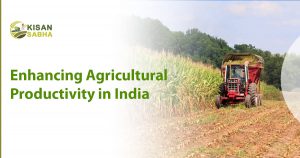The use of organic farming has been on the rise recently due to the growing concerns about the conservation of natural resources in farming. Biofertilizers are one of the most important components of organic farming. Are biofertilizers biological inventive substances obtained from organisms, which improve soil fertility besides stimulating plant development? It is used in the same vein as chemical fertilizers and has multiple advantages for the soil as well as crops.
This article takes a closer look at the role played by biofertilizers in organic farming. Also, it analyses the issues and constraints related to biofertilizers, discusses their application in sustainable agricultural systems, and identifies and reviews the future and development trends of biofertilizers.
What are Biofertilizers?
Biofertilizers are those organic matter or live multicellular organisms, which can improve the fertility of the soil as well as the growth of plants. Biofertilizers are natural in origin unlike chemical fertilizers, and enable organisms to live in cooperation.
Importance of Biofertilizers
Biofertilizers have been in use even from historical periods that include the Indus Valley civilization and the ancient Egyptians. A good example is that those early farmers understood the benefits of applying natural inputs like animal dung and compost on their fields.
In the modern world, the usage of biofertilizers remains highly significant. Due to increasing interest in organic farming and the detrimental effect of chemical fertilizers on the environment worldwide, the importance of biofertilizers remains the fundamental tool in organic farming. They serve as a foolproof remedy for supplementing the nutrients required for plant growth and development.
Advantages of Using Biofertilizers in Organic Farming
Enhanced Acquisition of the Nutrients in the Soil
Biofertilizers are pure products of microorganisms for decomposing organic substances and releasing required nutrients in plant-available forms.
This enhances the kindness of the nutrients in the soil hence availing planting nutrients to support healthy plant growth.
Proper Soil Health and the Microorganisms within the Soil
Biofertilizers add useful microbes in the soil like Rhizobium, phosphorus solubilizing fungi, etc. Such microorganisms are useful in soil health as they help to build soil structure, make nutrients mobile, and inhibit pathogenic organisms. They also promote the activity of microbes, resulting in improved ground soil ecology.
The development of Harder and Healthier Plants with Higher Yields
Biofertilizers increase nutrient availability in the soil and thus result in improved plant growth and higher yields. The plants that are being grown by using biofertilizers are more healthy, and disease resistant. In addition, it has the added advantage of, not only improving lower, or farmer yield but also making the agricultural process and the entire food chain more sustainable and robust.
Also Read:- Increasing Beneficial Insects for Sustainable Farming
Varieties of Biofertilizers and Their contribution to the improvement of soil fertility
Diazotrophs or Nitrogen-Fixing Biofertilizers
Nitrogen is an essential nutrient for the growth of plants and is also available in the atmosphere, nitrogen-fixing bio-fertilizers are the rhizobium bacteria that fix it into a soluble form acceptable to plants. Several such biochemical fertilizers are most effective for legumes, as the plants fix nitrogen in root nodules.
Organic Phosphate Solubilisers also called Phosphate Mobilising Bio-Fertilizers
Phosphorus is another essential nutrient for plant growth and mycorrhizal fungi sulfate as phosphate solubilization biofertilizers. These biofertilizers share a symbiotic relationship with plant roots, increasing their exploratory surface and enhancing phosphorus acquisition.
Potassium Mobilizing or Potassium Soluble Biofertilizer
However, potassium is necessary for all plants to meet their physiological needs, which helps carry out different functions. Potassium mobilizing biofertilizers including potassium solubilizing bacteria make potassium from the mineral sources in the soil available to plants. They also enhance increased plant productive growth, stress, and quality of produce harvested.
An Examination of the Efficiency of Biofertilizers on the Yield and Quality of Crops
Research Works and Experimental Evidence
Various researchers have carried out several experiments to establish the extent to which biofertilizers could help enhance crop production and productivity. From these studies, it has been clear that biofertilizers can improve plant growth and yield greatly. These biofertilizers enlighten the availability of nutrients in the soil, the uptake of these nutrients, and also the well-being of the soil. This results in higher crop output as well as enhanced quality.
A Comparative Analysis with Chemical Fertilizers
In general, when contrasted with chemical fertilizers, biofertilizers are subsequently advantageous. When the nutrients mix in the chemical fertilizers, they cause a quick and direct release of nutrients. Also, they do not cause any harm to the environment and also exhaust the soil fertility. In contrast, biological fertilizers are natural and organic keeping a balance with nature, and encouraging sustainable agriculture. However, the benefits you derive from biofertilizers may not be felt immediately. They help in the long run and can also help in the improvement of the ecosystem.
Conclusion
In conclusion, in light of the different advantages and importance, biofertilizers tend to be viewed as a fundamental factor of organic farming. Organic farmers benefit from their ability to improve nutritional absorption, soil conditions, and plant yields. Nonetheless, there are several challenges that biofertilizers face due to research and technology development, and the prospects for these types of fertilizers are improving shortly. As more research is conducted on biofertilizers, the general use of biofertilizers is likely to increase the use of ecological agricultural practices, thereby contributing to shaping a healthy future for the soil and produce.




